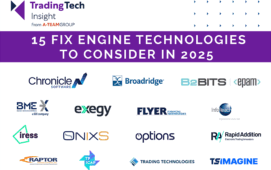
 By Chris Hollands, Head of European and North American Sales, TradingScreen
By Chris Hollands, Head of European and North American Sales, TradingScreen
Farewell to the 2010s, the decade of pure speed. The period when automated trading shot up the curve, ascending from a tool of the early adopters to a cross-asset industry norm. We embraced algorithms as our trump card, so much so that they now account for the lion’s share of buy-side equities orders and FX trades, and have growing importance in fixed income and other traditionally high-touch workflows.
Electronic trading will continue to shape our industry’s future, delivering the speed, scale and embedded compliance that provides a competitive edge. But from hereon in, it’s not only the automation that will shape the future. In the 2020s, the broader application of newer, more advanced technologies will underpin the endeavours of the buy-side trading desk.
Thanks to the exponential advances in machine learning and analytics visualisation, algorithmic trading technology has almost reached an infinite level of customisation. Savvy brokers and their algo development partners can create increasingly sophisticated and high performing execution strategies in an agile manner. With or without high touch, the era of bespoke broking is back, but with much greater efficiency.
So how does the buy side best equip itself to leverage these solutions? Today’s SaaS trading tools provide the most robust and scalable option to facilitate the following capabilities:
- Plan, back-test and analyse: Next-generation tools and platforms enable traders to efficiently extract vast samples of historical tick data, and even real-time analytics for back-testing and research. It is therefore possible to predict how a proposed trading strategy behaves over different market cycles to help determine long term profitability. Such insights can help generate custom and interactive real-time visualisations to reveal opportunities more intuitively.
- Design, develop and deploy: With open source APIs, traders can convert their trading insights into custom strategies and connect their unique algorithms to a SaaS deployed trading network such as TradeSmart, and trade across all markets and asset classes via one connection. Through integrated compliance engines, the challenges of an increasingly complex regulatory landscape can be swiftly navigated allowing order flow to reach the desired counterparty, liquidity provider or venue as seamlessly and efficiently as possible.
- Monitor, adapt and execute: A flexible workflow, supporting both solicited and unsolicited order generation requires a fluid interconnection between the OMS and the EMS, which often has not been the case. This interplay not only enables engagement with disparate and diverse data sources and multiple trading protocols, but also real-time execution reporting and analytics which can be fed into the pre-trade decision-making loop.
In summary, all-asset-class connectivity, open SaaS architecture and a fully integrated data model are the essential ingredients for optimal execution for the buy side. Access to pre-canned referential data, a flexible range of live market data and streaming price feeds, together with an out-of-the-box historical database that generates its own custom indicators and proprietary trading strategies, cannot be understated. These content and functionality rich capabilities all contribute to the buy-side’s central objectives of best execution, the maximisation of operational efficiencies and the reduction of TCO.
Subscribe to our newsletter




